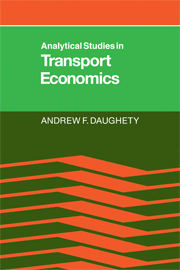Book contents
- Frontmatter
- Contents
- Contributors
- Preface
- INTRODUCTION
- TECHNOLOGY AND DEMAND
- 2 Augmentation effects and technical change in the regulated trucking industry, 1974–1979
- 3 An econometric analysis of the cost and production structure of the trucking industry
- 4 Network effects and the measurement of returns to scale and density for U.S. railroads
- 5 Using indexed quadratic cost functions to model network technologies
- 6 Joint estimation of freight transportation decisions under nonrandom sampling
- EQUILIBRIUM, PRICING, AND MARKET BEHAVIOR
- Index
6 - Joint estimation of freight transportation decisions under nonrandom sampling
Published online by Cambridge University Press: 07 October 2011
- Frontmatter
- Contents
- Contributors
- Preface
- INTRODUCTION
- TECHNOLOGY AND DEMAND
- 2 Augmentation effects and technical change in the regulated trucking industry, 1974–1979
- 3 An econometric analysis of the cost and production structure of the trucking industry
- 4 Network effects and the measurement of returns to scale and density for U.S. railroads
- 5 Using indexed quadratic cost functions to model network technologies
- 6 Joint estimation of freight transportation decisions under nonrandom sampling
- EQUILIBRIUM, PRICING, AND MARKET BEHAVIOR
- Index
Summary
An understanding of the determinants of the demand for intercity freight transportation has been a necessary input into economists' analysis of positive and normative issues in freight transportation such as the welfare effects of rate deregulation, the benefits of railroad mergers, and the potential demand for new freight modes. The freight demand models that have been used to address these issues have focused on the determinants of the choice of freight mode but ignored other important transportation or production decisions that may be related to this choice. These decisions include the quantity of a commodity to ship (shipment size) and the frequency of shipments. Consequently, the theoretical characterization of the freight transportation decision-making process that underlies previous freight demand models is incomplete. Further, estimates of key magnitudes like market elasticities and shippers' value of time that have been derived from these models may be flawed if the mode choice is only part of a larger joint decision process.
The purpose of this chapter is to provide a theoretical characterization of the freight transportation decision-making process that enables one to analyze the mode choice decision jointly with the shipment size, shipment frequency, and production decisions. This characterization is particularly relevant for analyzing shippers' behavior in the recently deregulated freight transportation environment as it has been widely recognized that firms will make greater efforts than they have under regulation to coordinate their production and transportation decisions in order to take advantage of the variety of price and service offerings that have emerged under deregulation.
- Type
- Chapter
- Information
- Analytical Studies in Transport Economics , pp. 137 - 158Publisher: Cambridge University PressPrint publication year: 1986
- 20
- Cited by

